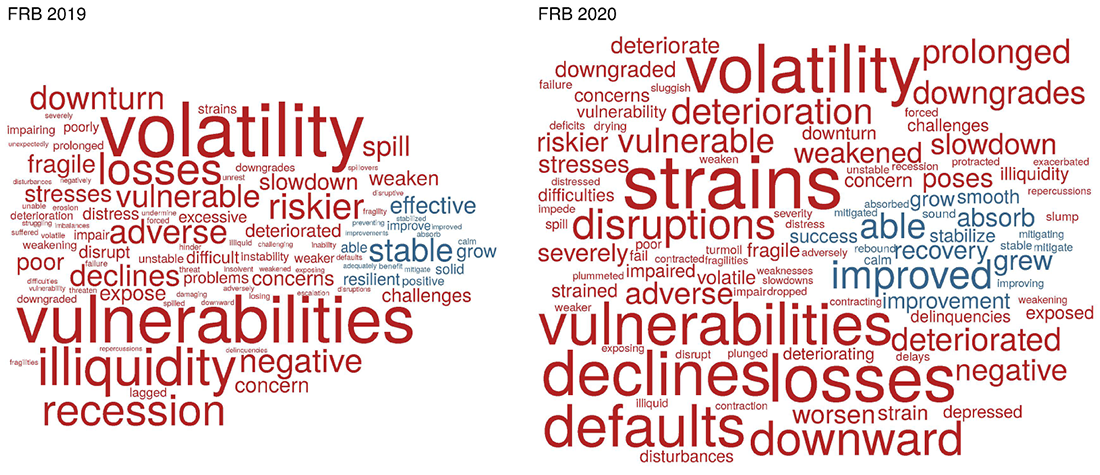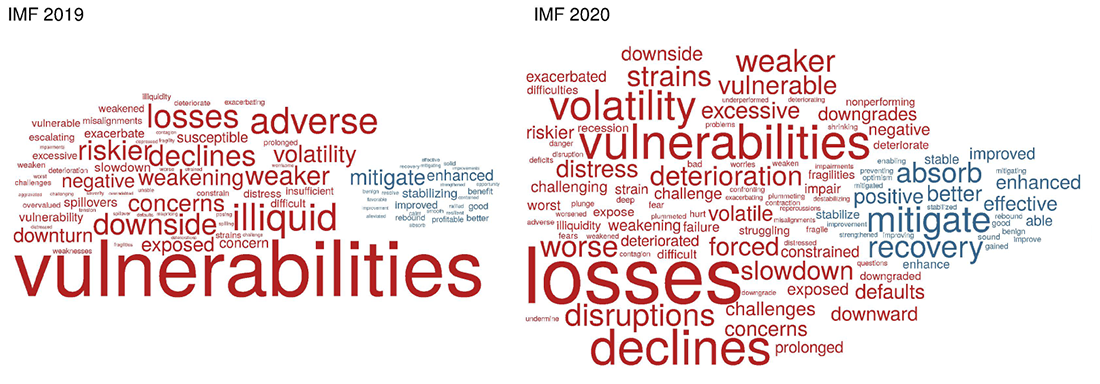FEDS Notes
September 18, 2020
Central Banks' Financial Stability Communications during the COVID-19 Pandemic
Jerry Yang, Ricardo Correa, and Juan M. Londono
The COVID-19 pandemic has led to the implementation of unprecedented policy actions by central banks around the world. Along with the reduction of interest rates and the use of asset purchase and lending programs, central bank communications have been actively deployed as a policy tool. In this note, we center the attention on financial stability communications of central banks and the International Monetary Fund (IMF). Using the methodology proposed in Correa, Garud, Mislang, and Londono (2020), we measure the sentiment in official financial stability reports (FSRs) and compare changes in this sentiment since the beginning of the pandemic for 17 countries and the IMF to gain more insight about communication strategies around this period.1
We find that sentiment deteriorated considerably in almost all FSRs in the first half of 2020, but the intensity of these changes in sentiment differs across countries. Central bank communications appear to have been influenced primarily by these institutions' perception of the pandemic's impact on financial stability in their respective countries. Specifically, the deterioration in sentiment is positively correlated with concerns about the pandemic, expressed not only in FSRs but also in news articles. We also find a weaker relation between the change in sentiment for individual countries and the level of financial vulnerabilities and public health indicators in each country. However, we do not find that changes in observed or expected future economic conditions significantly explain the differences in changes in sentiment related to financial stability across countries. Overall, our findings suggest that the unprecedented nature of the pandemic notably increased the level of uncertainty about the future economic and financial paths of these countries, which created a disconnect for central banks between their perceived impact of the coronavirus outbreak, measured by the FSRs' sentiment, and tangible financial stability and real-time economic indicators.
Financial Stability Sentiment Index
To assess the sentiment in central bank financial stability communications, Correa, et al. (2020) construct a financial stability dictionary (.xlsx) that classifies words into positive, negative, or neutral depending on the sentiment they convey. We use this dictionary to calculate a financial stability sentiment (FSS) index as the proportion of negative to positive words,
FSScountry,period=#Negative Words−#Positive Words#Total Words×100.
By construction, a higher FSS represents a deterioration in financial stability sentiment.
Of the central banks and multilateral organizations that routinely publish FSRs in English, 18 have released reports in 2020, including the Federal Reserve Board (FRB), nine additional central banks in advanced economies, seven in emerging market economies, and the IMF. Figure 1 shows the average demeaned FSS indexes for these groups since 2018. Compared to the last FSRs published in 2019, sentiment deteriorated in 15 reports (see Table A.1. for changes in FSS indexes for all FSRs in our sample), which is reflected in the increase observed for the United States (FRB), and for the aggregates of the other advanced economies and the emerging market economies. In contrast, sentiment improved slightly in the IMF's FSR, which is noteworthy, because the sentiment conveyed in this report has typically been a good predictor of financial crises (Correa, et al. 2020).2
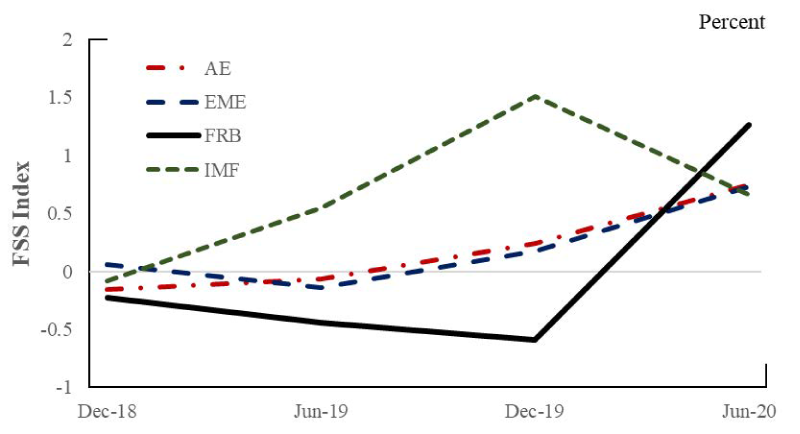
Note: This figure shows the demeaned FSS indexes for the Federal Reserve Board, all other advanced economies, emerging market economies, and the IMF. Each individual FSS index is demeaned using the entire sample of recorded FSR publications (for example, starting in 1999 for Sweden). Advanced economies are composed of Australia, Canada, Denmark, Estonia, Hong Kong, Spain, Sweden, Switzerland, and he United Kingdom. Emerging market economies are composed of Brazil, Chile, Hungary, Indonesia, Poland, South Africa, and Turkey.
Source: Author's calculations based on the financial stability reports published by the International Monetary Fund and the central banks in the sample.
To further explore the divergence between the FRB's and IMF's FSRs, Figures 2a and 2b compare word clouds for these reports in 2019 and 2020. A cursory analysis of these word clouds suggests that the FRB (Figure 2a) used more negative words in 2020, with a specific focus on terms such as strains, defaults, volatility, declines, and losses. In contrast, as shown in Figure 2b, the IMF moved from a discussion of vulnerabilities in 2019 to losses in 2020, but also began to use more positive language associated with the resilience of the global financial system, with words such as mitigate, recovery, and absorb. The contrast between these FSRs highlights the differences in communication strategies that central banks and multilateral organizations may follow and is an example of some of the cross-sectional variation in financial stability sentiment explored in the next section.
Note: These figures show word clouds for FSRs in the second half of 2019 and the first half of 2020 for the Federal Reserve Board (2a) and the International Monetary Fund (2b). The size of the words in each cloud is determined by their relative frequency of use so larger words are more frequently used in each report. They only include positive (in blue) and negative (in red) words in the financial stability dictionary.
Source: Author's calculations based on the financial stability reports published by the Federal Reserve Board and the International Monetary Fund.
What explains the changes in FSS indexes across countries?
We explore four potential explanations for the differences in FSS changes across countries. The first explanation is related to financial vulnerabilities at the beginning of the outbreak, as central banks in countries with more vulnerable financial systems may have decided to convey a more negative sentiment. The second focuses on the measured and expected economic impact of the coronavirus in each country at the time of publication of the FSR. The third one is associated with the severity of the outbreak, measured in cases and deaths per million inhabitants in each country. Last, we focus on central banks' qualitative perception of the pandemic's impact, as captured by the intensity of its coverage in FSRs and the news.
Figure 3 addresses the first explanation and compares the change in FSS indexes from 2019 to 2020 with a measure of financial vulnerabilities proposed by Lee, Posenau, and Stebunovs (2020) named the LPS score, which is a composite index for various indicators of financial vulnerabilities; a higher LPS value is associated with more financial vulnerabilities. The figure suggests that there is a small positive, although not statistically significant, relation between LPS scores and changes in FSS indexes. We find a similar relation between the change in financial stability sentiment and the credit-to-GDP gap, another measure of financial vulnerabilities used to forecast financial crises (see Borio, 2014), as of end-2019 (not shown). Financial vulnerabilities may have influenced the sentiment in FSRs, but their variation across countries does not significantly account for the change in sentiment during the COVID-19 outbreak.
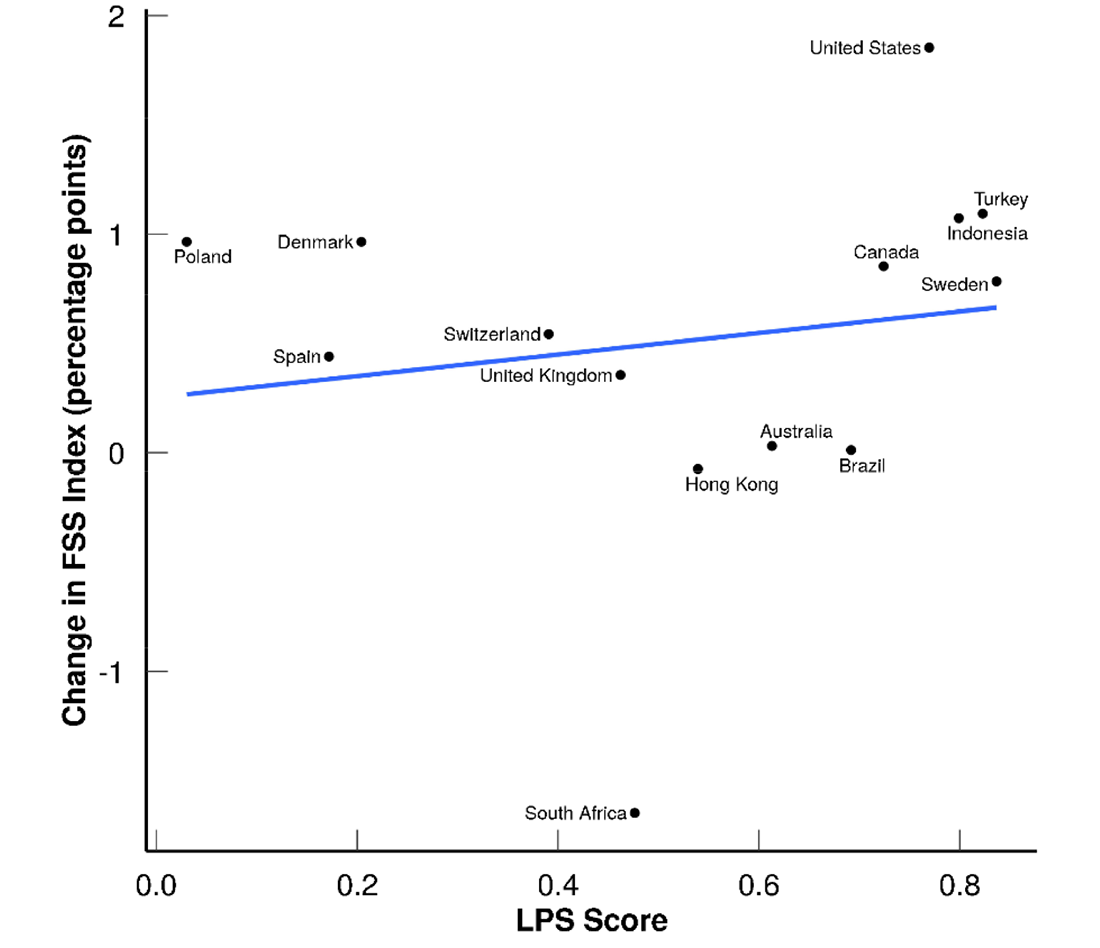
Note: The scatterplot shows the change in FSS indexes on the y-axis and the December 2019 LPS score on the x-axis. The LPS score is measured every month and is a composite of various indicators, such as the credit-to-gdp gap and asset valuations measures. Chile, Estonia, and Hungary are omitted from the scatterplot, as LPS scores are not available for these countries.
Source: Lee, Posenau, and Stebunovs (2020) for the LPS Score and author's calculations based on the financial stability reports published by the central banks in the sample.
In Figure 4, we assess whether economic performance, measured as GDP growth between 2019Q4 and 2020Q1, is associated with changes in the sentiment in FSRs. This relation is not statistically significant and, notably, in the opposite direction as what one might expect, which suggests that central banks in countries that performed relatively better during the first quarter of 2020 communicated more concerns about financial stability. We have conducted similar tests comparing changes in the FSS indexes with the modal forecast of GDP growth for 2020, changes in the unemployment rate, stock prices, and consumer confidence indexes, and all tests yield similarly weak results. These simple correlations suggest that reported or expected modal economic conditions were not a crucial driver of central banks' communications during this event.
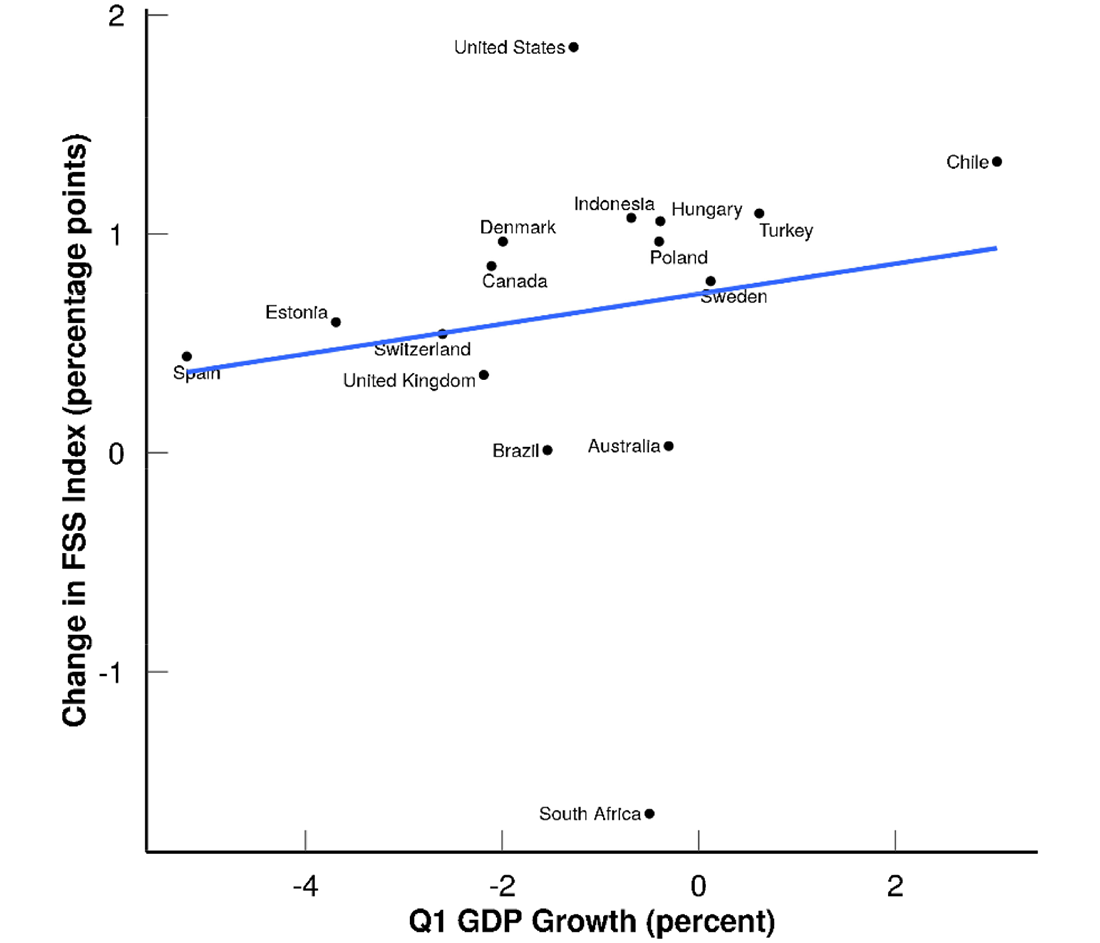
Note: The figure plots the change in FSS indexes on the y-axis and GDP growth (in percent) on the x-axis. The data for GDP comes from the OECD. Updated GDP data is not available for Hong Kong.
Source: Organization for Economic Cooperation and Development (OECD) and author's calculations based on the financial stability reports published by the central banks in the sample.
In Figure 5, we focus on the relation between changes in financial stability sentiment and the impact of COVID-19 on health outcomes. The positive, although not statistically significant, relation between FSS changes and the number of cases per million in each country is stronger than that for the LPS score, hinting that health outcomes could have played a relatively more important role in the assessment of financial stability conditions by central banks. However, the less than perfect relation between observed health outcomes and sentiment in FSRs is likely explained by the unprecedented nature of the virus and the lack of understanding of its disruptive ability. For instance, in the early stages, when these FSRs where published, authorities did not have sufficient data to assess the infection or mortality rates of the virus, which created notable uncertainties about the future path of the coronavirus and the authorities' potential actions to contain it. Therefore, we propose that uncertainties related to the virus are best captured in real time by the frequency of discussions about the pandemic.
We proceed to analyze this conjecture by comparing the change in the FSS index and the perception of disruptions associated with the coronavirus captured by the frequency of discussions about the pandemic in FSRs and in news articles. First, we construct a pandemic index for each FSR as the proportion of words that refer to the coronavirus.3 We find that this index has the strongest, although not statistically significant, positive relation with the deterioration in sentiment of any of the covariates analyzed, as shown in Figure 6. This finding suggests that financial stability communications were notably influenced by the central banks' perception of the potential negative effect of the COVID-19 pandemic on financial stability, even if those perceptions had not materialized by the publication of the reports.
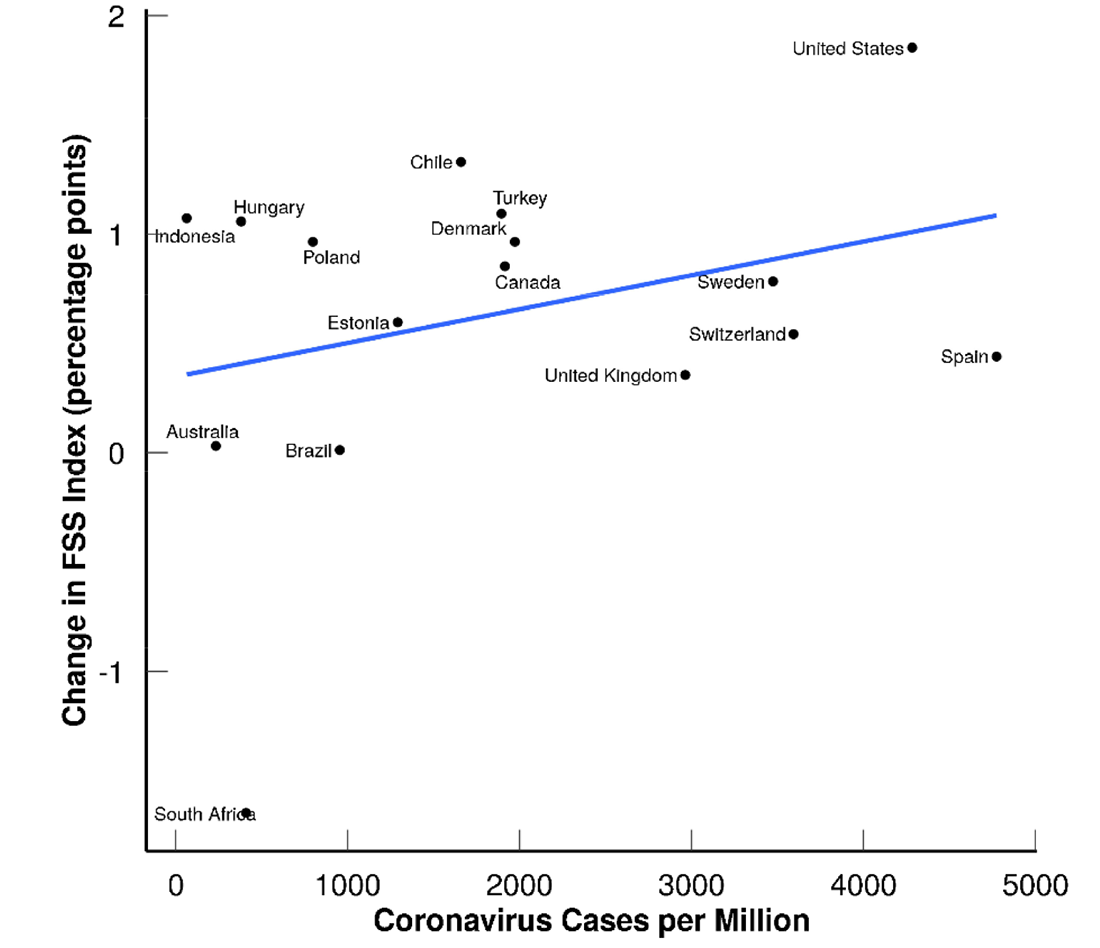
Note: The figure plots the change in FSS indexes on the y-axis and the number of coronavirus cases per million inhabitants at the date of the publication of each country's FSR on the x-axis. The data for coronavirus cases comes from Our World In Data, a project of the Global Change Data Lab.
Source: OurWorldInData and author's calculations based on the financial stability reports published by the central banks in the sample.
To assess whether this perception in FSRs was aligned with the perception of the coronavirus' impact outside of central banks, we investigate the relation between the concerns voiced about COVID-19 in the FSRs and those conveyed in news reports. To do so, we extract all articles from Reuters News included in Refinitiv's News Archive Database that pertained to financial stability topics in each country.4 For these articles, we calculate a pandemic index similar to that calculated for FSRs. The relation between the pandemic indexes from FSRs and from news articles is positive and significant, as shown in Figure 7.
In sum, our evidence supports the intuition that the deterioration of sentiment in central banks' FSRs in 2020 mainly reflected concerns about the COVID-19 pandemic and that central banks were particularly attuned to coronavirus developments in their respective countries, even more than to real-time economic indicators or uncertain forecasts.
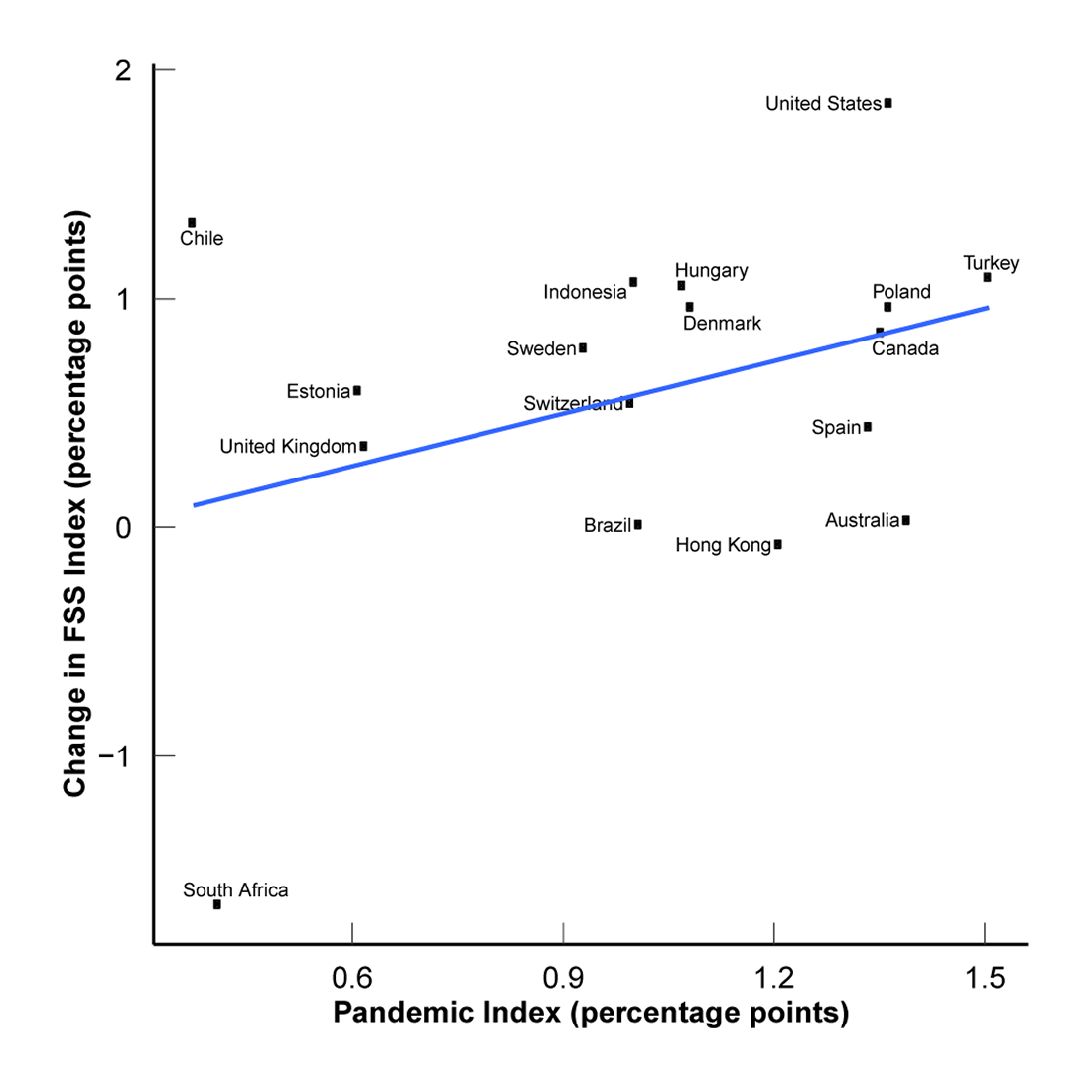
Note: This figure plots the change in FSS indexes on the y-axis and the FSR pandemic indexes on the x-axis for all countries in our sample.
Source: Author's calculations based on the financial stability reports published by the central banks in the sample.
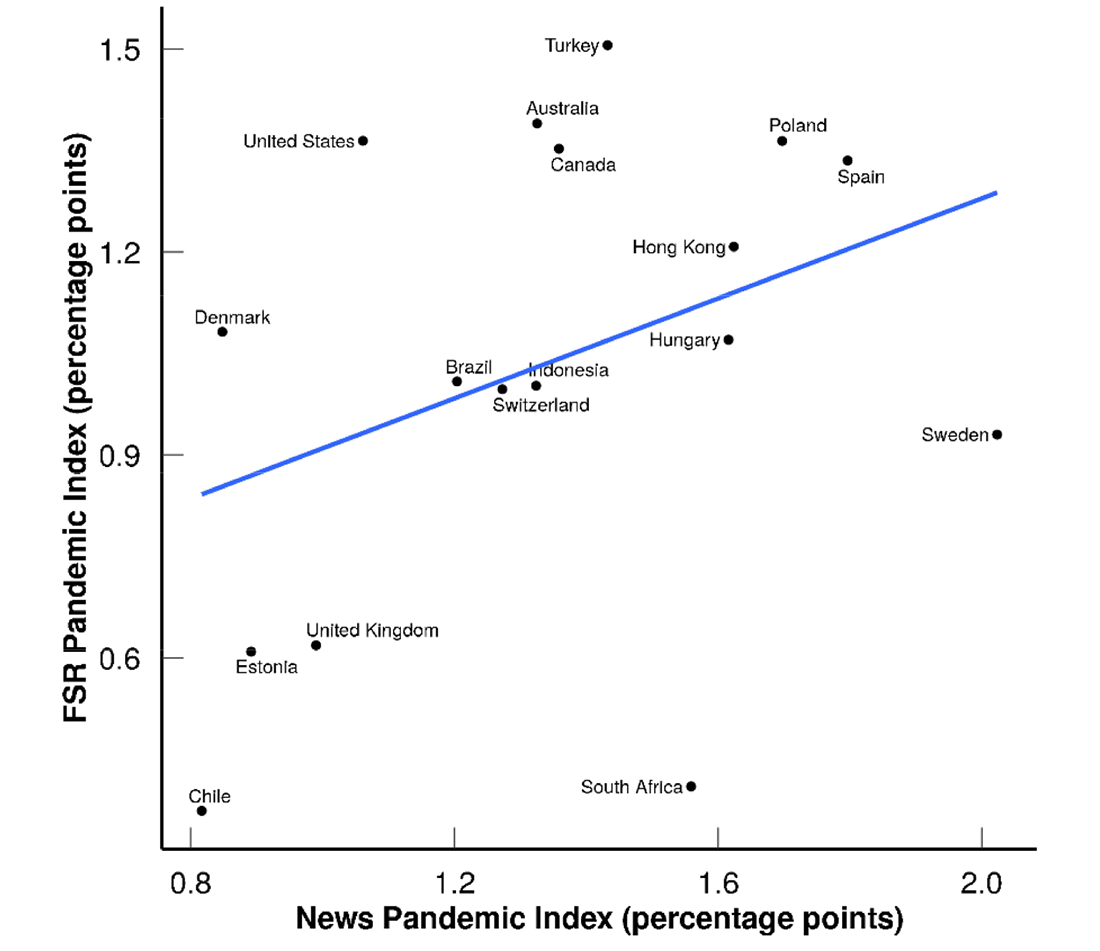
Note: This figure plots the FSR pandemic index on the y-axis and the 2020Q1 news pandemic index on the x-axis for all countries in our sample.
Source: Refinitiv News Archive Database and author's calculations based on the financial stability reports published by the central banks in the sample.
References
Borio, Claudio (2014), The financial cycle and macroeconomics: What have we learnt? Journal of Banking and Finance 45, 182-198.
Correa, Ricardo, Keshav Garud, Juan M. Londono, and Nathan Mislang (2020), Sentiment in Central Banks' Financial Stability Reports. Review of Finance, forthcoming.
Lee, Seung Jung, Kelly E. Posenau, and Viktors Stebunovs (2020), The Anatomy of Financial Vulnerabilities and Crises. Journal of Banking and Finance 112, 1-17.
Roser, Max , Hannah Ritchie, Esteban Ortiz-Ospina and Joe Hasell (2020), Coronavirus Pandemic (COVID-19). Published online at OurWorldInData.org. Retrieved from: 'https://ourworldindata.org/coronavirus'.
Appendix
A1: Change in FSS by Country
Table 1a
| Country | Australia | Brazil | Canada | Chile | Denmark | Estonia | Hong Kong | Hungary | IMF |
|---|---|---|---|---|---|---|---|---|---|
| Date | 8-Apr | 15-May | 14-May | 13-May | 27-May | 7-May | 30-Mar | 22-May | 14-Apr |
| FSS Change (p.p.) | 0.031 | 0.012 | 0.853 | 1.331 | 0.965 | 0.597 | -0.074 | 1.058 | -0.849 |
Table 1b
| Country | Indonesia | Poland | South Africa | Spain | Sweden | Switzerland | Turkey | United Kingdom | United States |
|---|---|---|---|---|---|---|---|---|---|
| Date | 18-May | 17-Jun | 27-May | 8-May | 28-May | 18-Jun | 28-May | 7-May | 15-May |
| FSS Change (p.p.) | 1.073 | 0.965 | -1.648 | 0.440 | 0.784 | 0.543 | 1.094 | 0.356 | 1.854 |
Note: The table details the change in FSS indexes (in percentage points) by country between the last report in 2019 and the first report in 2020, along with the publication date of each report.
Source: Author's calculations based on the financial stability reports published by the International Monetary Fund and the central banks in the sample.
1. The countries' financial stability reports are published by their respective central banks, while the IMF publication is its global financial stability report (GFSR). Return to text
2. The time series for all countries' FSS indexes can be found in https://juanmlondono.wordpress.com. Return to text
3. The set of words used is composed of outbreak, corona, coronavirus, covid-19, covid, pandemic, disease, quarantine, and stay-at-home. Return to text
4. To identify the news articles associated with each country, the stem of the country's name is searched in the headlines and the body of all news articles. For example, articles with "Turk" in the headline are associated with Turkey. Articles with financial stability topics are selected by searching for financial stability bigrams that were common in FSRs, such as "banking system" and "financial stability." The full list of bigrams is available upon request from the authors. Return to text
Yang, Jerry, Ricardo Correa, and Juan M. Londono (2020). "Central Banks' Financial Stability Communications during the COVID-19 Pandemic," FEDS Notes. Washington: Board of Governors of the Federal Reserve System, Septermber 18, 2020, https://doi.org/10.17016/2380-7172.2741.
Disclaimer: FEDS Notes are articles in which Board staff offer their own views and present analysis on a range of topics in economics and finance. These articles are shorter and less technically oriented than FEDS Working Papers and IFDP papers.
